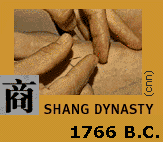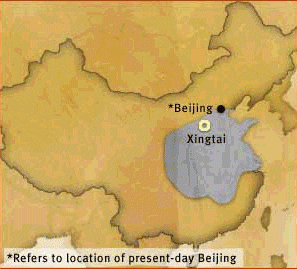last updated 9/14/99 3AM
Chinese
Myth-History Versus the Written Evidence of Xia, Shang, and Zhou
Significant terms:
* cicada
* oracle bones
* I-Ching
* Chinese written characters
* Mandate of Heaven
* ren
* li
Outline of Dynasties, Evidence, and Myth
History:
| Period |
Evidence |
Myth-History written after
500 BC (late Zhou) |
| Xia
2000-1700 |
No evidence for one central
culture or even writing. There were numerous neolithic centers with
distinct cultures in the Yellow River basic and the Yangtze. Pottery is
more highly developed in the Yangtze basin. Bronze work is evolving in
the Yellow. |
Founding dynasty of the Han.
Legendary fathers of animal husbandry, farming, the family, and the
trades arise. |
| Shang
1600-1045 |
First hard evidence of
Chinese writing found on bronze vessels and divinations (oracle
bones). |
Increasingly corrupt rule by
Xia tyrants who "needed" to be overthrown because they had lost the Mandate of Heaven |
Zhou
(Western) 1045-771
(Eastern) 770-256
(Spring and Autumn) 770-476
(Warring States to Six Kingdoms) 475-221 |
Record of the Zhou
conquering the Shang on bronze vessels and histories written hundreds of
years later. |
Early rulers exemplary Sons
of Heaven, coming from humble origins and ruling benevolently. Ruler as
family motif is established along with Mandate of Heaven/Dynastic Cycle
concept. *Ren (the Confucian concept of filial humanity) and *li (all
related rituals and customs of the state) become a theme of Chinese
socio-political consciousness. Contrast what is developing in the
Greco-Roman world at this time. |
Until the Shang period around 1600 BCE, there
is no evidence of a distinctly Chinese culture. During the Shang period, between 1700 and 1050 BCE, the first written
evidence of Chinese civilization appears in the form of oracle bones and I-Ching
readings. Many of the symbols used at this time has continued to be used up to
the present day in China and Japan. From the evidence
of the oracle bone divinations and the I-Ching, we begin to see what the culture
was like at the time, and how the people viewed their world at large.
Oracle bones
-
Turtle shells and bones from
Cattle and Pigs. The turtle had some sacred qualities that persist in Asia and
other parts of the world to this day.
-
Professional diviners had a
monopoly on the writing and reading. Reliance on a professional, educated
class begins at this time. (Contrast this development to
phonetic alphabets developing in Mesopotamia and the Greek world which
facilitated trade among various non-elite peoples.)
What can you
conclude about Shang culture from the theses hints and more in the Oracle bones?
I-Ching
What can you
conclude about Shang culture from the theses hints and more in the I-Ching?
Other evidence from Shang Bronzes
and Artwork.
Another source found that Shang corpses have been
found with a cicada in their mouths. What could have the cicada represented to
them? Here is a link to a burial vessel that uses cicada
wing designs.
Here is a site with a lot of Shang
Artwork.
Here's a snippet from the current CNN/Time/Asia Week special on
China:
 [Shang] is the first historically verifiable Chinese dynasty. Believed to have existed
for 600 years -- [between 1766 and 1100 BCE]. It is known for its use of acupuncture, elaborate bronze ritual
vessels, oracle bones to determine the future and the earliest standardized form
of Chinese characters.
[Shang] is the first historically verifiable Chinese dynasty. Believed to have existed
for 600 years -- [between 1766 and 1100 BCE]. It is known for its use of acupuncture, elaborate bronze ritual
vessels, oracle bones to determine the future and the earliest standardized form
of Chinese characters.
 The
Shang became the most developed Bronze civilization in the world at the time. It
is on Bronze vessels and oracle bones that we have the first evidence of Chinese
written language. Many of these symbols continue to the present day in China and
Japan.
The
Shang became the most developed Bronze civilization in the world at the time. It
is on Bronze vessels and oracle bones that we have the first evidence of Chinese
written language. Many of these symbols continue to the present day in China and
Japan.
Human sacrifice is another
distinguishing characteristic of the Shang. Upon the construction of new
buildings and the burial of prominent leaders, human sacrifice was common. In
later dynasties, terra-cotta figurines replaced living sacrifices. Their system
of succession was unique and may represent a transition from matrilineal
practices of the early Neolithic period to the patrilineal practices of the
dynasties after this period. The kingship passed from brother to younger
brother, and if there were no more brothers, to the oldest maternal nephew (From
a source called "in-contact with china" http://www.china-contact.com/www/history/shang.html).
What does the
Shang tell us about the evolving Chinese culture on the edge of the Neolithic
(Agricultural) Revolution? How does it appear to set the stage for subsequent
Zhou and Han Chinese Civilization?
Passing of the Mandate of
Heaven, from Shang to Zhou
According to later reports by
Confucian scholars during the recorded during the Zhou period, the Shang rulers
had become increasingly corrupt and tyrannical. Between the Shang capital and
the western frontier, the Zhou rose against the Shang to defeat them. Several
hundred years later, this story of a just victory over tyrants to restore the
"Mandate of Heaven" for "All under Heaven (representing the
confederation of Chinese states). This account is only written several hundred
years after the fact in one of the Confucian classics, the "Book of
Documents" (the Shujing). To Confucius, the early Zhou rulers, over two
hundred years earlier, were ideal rulers, keeping order through a decentralized,
exemplary style of rule of benevolence. King Wu, the victorious king, paid
proper reverence to the Shang ancestors by leaving the defeated Shang king's son
on the thrown. Confucius gives the Duke of Zhou, although he was only a regent
to the young king, credit for securing the whole eastern region of the Yellow
plain for the new empire. The exemplary rule of these early Zhou rulers came to
represent ideal social relations -- from the Son of Heaven, the emperor, to the
farmer's family working on a fief.
It was during a period of decline
in the Zhou between 770 and 256 BCE, the Eastern Zhou period, (divided into the
Spring and Autum period -- 722-481 BCE. -- and the Waring States period
--403-221 BCE.) that China's philosophic and political traditions are born in
scholars vying for influence in the decreasing number of states as the stronger
ones defeat the weaker. In the writing of its mythic past, Confucius and other
scholars around 500 BC create China's myth history tracing a story line that
begins with legends of the distant Xia dynasty founders: Fu Zi; the domesticator
of the ox and inventor of the family, Shen Nong, the Divine Farmer and inventor
of the plough and the hoe, and Huang Di, the Yellow Lord, inventor of the bow
and arrow, boats, ceramics, writing, and silk. Archeologists know that during
the Xia period, China had numerous Neolithic centers of culture, including trade
networks that linked these centers with centers in other parts of Asia and
Europe. Confucius and other Zhou conservatives held up a total of five mythic
rulers including two more, the Yao and Shun, who came to represent attributes
that Confucian scholars believed to be important: Yao is said to have invented
the calendar and rituals, or li; and Shun is said to have represented humanity
or jen, a concept that makes filial piety the basis for all human relations. In
the overthrow of the Xia and the Shang, respectively, corruption had caused
rulers to become tyranical and lose their Mandate from Heaven. The ruler must
rule benevolently as a father would his family if he is to maintain his Mandate
of Heaven according to Confucius.
Confucius's story is not the only
one however. Other responses to the moral crisis during the Warring States
period stimulated numerous schools who each tried to pitch their ideas on
government to the local war lords concerned with maintaining order over their
expanding domains.
What were the
main schools of thinking and how were they different? Which one won out in the
consolidation of states near the second century BCE.?
To be continued. . .
Back to
Syllabus/E-Zine Index
 [Shang] is the first historically verifiable Chinese dynasty. Believed to have existed
for 600 years -- [between 1766 and 1100 BCE]. It is known for its use of acupuncture, elaborate bronze ritual
vessels, oracle bones to determine the future and the earliest standardized form
of Chinese characters.
[Shang] is the first historically verifiable Chinese dynasty. Believed to have existed
for 600 years -- [between 1766 and 1100 BCE]. It is known for its use of acupuncture, elaborate bronze ritual
vessels, oracle bones to determine the future and the earliest standardized form
of Chinese characters. The
Shang became the most developed Bronze civilization in the world at the time. It
is on Bronze vessels and oracle bones that we have the first evidence of Chinese
written language. Many of these symbols continue to the present day in China and
Japan.
The
Shang became the most developed Bronze civilization in the world at the time. It
is on Bronze vessels and oracle bones that we have the first evidence of Chinese
written language. Many of these symbols continue to the present day in China and
Japan.